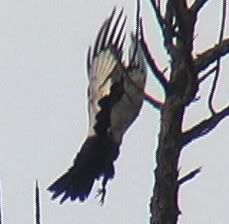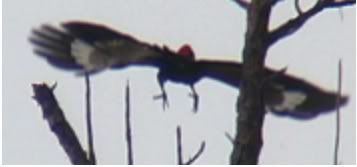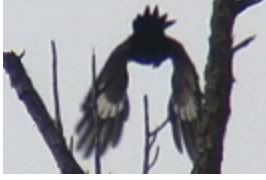Specifically, the Swan Pileated video proves that a fleeing, normal Pileated shows a lot of flashing white underwing, both when the wings are above horizontal and when the wings are below horizontal.
Some people have tried to dismiss the Swan Pileated video because "the camera is directly under the bird", but note that the camera angle is not constant throughout the entire video. In the frames below, the camera orientation is nearly directly behind the bird (note that you can see the head sticking up on the second picture).
Note also that you'd see a lot of white underwing in any of these pictures, even if you changed the orientation of the bird a number of degrees in any (X/Y/Z) plane.







5 comments:
Specifically, the Swan Pileated video proves that a fleeing, normal Pileated shows a lot of flashing white underwing, both when the wings are above horizontal and when the wings are below horizontal.
It proves that a fleeing, normal Pileated shows that at that camera angle. (more discussion below)
Some people have tried to dismiss the Swan Pileated video because "the camera is directly under the bird", but note that the camera angle is not constant throughout the entire video. In the frames below, the camera orientation is nearly directly behind the bird (note that you can see the head sticking up on the second picture)
I'll agree that the camera is nearly directly behind the bird in the 2nd picture (though note that the tail does appear to be visible "above" the body, showing that it is probably descending in relation to the camera, and note that the bird in the Luneau video is gaining altitude both in relation to the camera and the ground); however, there aren't other frames at this angle to show what the wings look like throughout the entire range of movement. The third and fourth frames clearly have the tail "above" the body, which shows that the camera has a much better view of the underside of the bird than in the Luneau video.
I would also argue that the amount of white shown on this bird is less than that in the Luneau video, though the backlighting makes assessing this difficult. Except for the frame showing the wings almost directly up, the only clearly white areas are at the base of the primaries where the light is able to shine through the top of the wing. The white underwing coverts actually look gray in these frames, obviously because of the lack of light reaching them. As I said, there is much more backlighting in this video than Luneau's, but then you must also wonder how much light is reaching the birds underwings in the Luneau video, giving that it was taking under tree cover (albeit before total leaf out) and apparently on a cloudy day. Under those conditions, would the underwings of a Pileated still appear obviously white? I don't know.
I agree that the Swan video is interesting and helpful, but for reasons perhaps differing from Tom and others here. The Swan video strongly suggests that you will almost (if not always) see black trailing edges to the wings as a pileated flies away from the camera, regardless of angle.
No one to my knowledge is saying that you never see lots of white on Pileated underwings, in the forward position anyway. That in some cases the angle of a flying Pileated "rowing" away from you, you may mistake the white of the forward portion of the underwing as a trailing edge is an interesting and important point that does need to be addressed. However, I think we must await further detailed analysis by those schooled in picking apart "fuzzy videos" about how it is possible that a Pileated would almost always show "white as a trailing edge" as it flies away from the camera.
In other words is it possible that a Pileated flying away does so by having its wings appear inverted (forward part of the wing always facing backwards, or at least appearing that way depending on the angle)at almost all times and then only showing the underside of its wings, and never the upperside, as the bird flies away from you? That is an interesting if not convoluted interpretation of how Pileateds appear as they fly away from you or a camera. Perhaps that is the case, but I have never seen this and Swan's video doesn't show this convoluted, inverted wing position, on either wing, as the bird flies away.
In almost every frame the extensive black trailing edge is obvious in Swan's video and facing the camera, and it appears to my admittedly untrained eye that the bird flying away from the Luneau camera shows nothing but white, lacking any hint of a black trailing edge, apprently both upper wing and underwing views. There may be the occasional frame in the Luneau video where it is not clear what color the trailing edge is, but where you can see the wing(s) relatively well, the trailing edge always appears white. From what I understand from the Cornell analysis, they have not only used models, but also have lots of footage of Pileateds, at every conceivable angle, and not once did they document anything other than a black trailing edge as the bird flies away from the camera, including very out-of-focus frames.
Again maybe there exists one or more series of frames, out of focus or otherwise, of Pileated showing nothing but white as it flies away from a camera. I am just waiting to see this for myself.
On a related note, some folks have mentioned not seeing the black stripe down the middle of the underwing in the Luneau video as a good reason to doubt the interpretation in the Luneau video by Cornell et al. Again an interesting point. Recently I became aware of a collection of James Tanner's photos taken during his time at the Singer Tract. These photos are available for viewing on a Louisiana State University website. This is indeed a treasure that I recommend everyone see for themselves, regardless of their views on the Luneau video, but one photo in particular may help on this point regarding what can be seen (or obscured) in the underwing of an Ivorybill (this time flying more-or-less towards the camera). Please see
http://panopticon.lib.lsu.edu/cgi-bin/viewer.exe?CISOROOT=/Tensas&CISOPTR=10&CISOMODE=thumb
I think it becomes more plausible when viewing this largely in focus frame about how an out-of-focus frame, where others have commented that white bleeds into dark in such cases, can obsure this field mark making the Ivory-bill's underwing appear almost all white.
By the same token if white always bleeds into dark in out-of-focus frames, the absence of any sequence of photos (that I am aware of anyway) showing a white trailing edge on all or most frames from normal Pileated flying away suggests Cornell may still have a point on this piece of crucial evidence.
Obviously all this is still subject to further anaylsis by independent trained investigators.
In sum, alot of folks are waiting for that "killer" photograph to accept this video as evidence and they may have a very long wait. However, it shouldn't be that hard for someone to come up with an out-of-focus photograph or video showing how a "normal" Pileated could show nothing but white on what appears to be the wings' trailing edge as it flies away from an observer. Unless of course that is not possible. However, I remain open-minded that it may be possible, I just haven't seen that evidence yet. I presume more will be revealed on this latter point very soon.
OK this may be simplistic, I know some see far more detail in the Luneau video than I do, but let’s start with only two assertions regarding a large woodpecker flying away from a viewer: 1) An Ivorybill would have three large white patches per wing... two below the wing and one on top of the wing 2) A Pileated would have one significant patch below.
Any given wingbeat may show or conceal one or more of the patches in the form of a flash of white. Without even attempting to distinguish top from bottom, or position of the patch on the wing, we now have three ways to positively ID an Ivorybilll and no way to positively ID a Pileated: Three white flashes per wing beat is an Ivorybill (one above and two below). Let’s call that ID(1). Two flashes per beat (one above and one below) would be Ivorybill from a different angle… ID(2). A different two flashes per beat (two below) would be a definitive Ivorybill from yet another angle ID(3).
Now if we assert that we can distinguish top from bottom in some instances we get a fourth way to positively ID an Ivorybill. Any flash on top is an Ivorybill. ID(4). There is still no way to positively ID a Pileated from only the assertions above.
Generally viewers have a hard time seeing the top of a wing and the underside of the wing simultaneously. Usually the top goes out of sight before the underside comes into sight, and vice versa. We might then expect two flashes per beat any time top and bottom are both viewed. The Science article though states:
“All visible wingbeats reveal extensive white patches on the posterior dorsal and ventral wing surfaces, representing entirely white secondary and innermost primary flight feathers.”
That’s top and bottom, but the video seems to show only one flash per beat. This might be ID(4a) in which the top and a bottom patch reveal themselves seamlessly in a single flash per beat. To claim an ID(4a), you’d have to be confident that you could distinguish top from bottom and you’d have to have the good fortune of being able to see the top and bottom of the wing simultaneously without a transition instant when you could see neither.
So the Science article seems to view the video as displaying ten consecutive beats of ID(4a), a tough call it seems, without a single beat of ID(1), ID(2), or ID(3), any of which would seem pretty hard to refute as evidence if witnessed... But as far as I can tell, they’re not there.
The video seems to indicate a camera about 12” above the water, the bird is at all times above the horizon and climbing, but never a double or triple flash. The Science paper sees all sorts of things I don’t see, and apparently others see them as well, but I’d like to see just one double flash in ten beats. That would be cool…
“All visible wingbeats reveal extensive white patches on the posterior dorsal and ventral wing surfaces, representing entirely white secondary and innermost primary flight feathers.”
That’s top and bottom, but the video seems to show only one flash per beat.
I can't say for sure, but Cornell may be referring to the part of the video at the beginning of the bird's flight, when it doesn't seem to be flying straight away from the camera. At this angle, when the bird is at the beginning of a downstroke, you can see the topside of the far wing and the underside of the near wing, or at least I believe that's what Cornell may mean by that statement.
As a side note, even though I've been arguing against the "it's obviously a normal Pileated" line of thought (though as I said before, I'm willing to accept that if a comparable video shows the same characteristics of the Luneau video), I don't think it's fair to say that a Pileated wouldn't show a flash of white from the topside of the wing, due to the white at the base of the primaries. It's more of a question of how big that flash would be.
There is a point on downbeats 4-6 (when the bird appears to be headed most directly away from the camera) that the white reduces noticeably in mid-downstroke, then reappears. I interpret this as the point when the wing is viewed nearly edge-on, switching from showing underwing white to upperwing white.
You know if you really use your imagination, on the first fully-visible downbeat as the bird appears from behind the tree, you can kind of pretend you see a few pixels that suggest a darker area in the middle of the white underwing ;)
Post a Comment